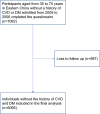Association of triglyceride-glucose index and traditional risk factors with cardiovascular disease among non-diabetic population: a 10-year prospective cohort study
- PMID: 36434636
- PMCID: PMC9700958
- DOI: 10.1186/s12933-022-01694-3
Association of triglyceride-glucose index and traditional risk factors with cardiovascular disease among non-diabetic population: a 10-year prospective cohort study
Abstract
Background: The triglyceride-glucose (TyG) index is known as a reliable alternative marker of insulin resistance (IR), which has been regarded as a predictor of cardiovascular disease (CVD). However, whether TyG index can predict the risk and occurrence of CVD in non-diabetic population remains uncertain. The aim of this study was to explore the association between the TyG index and cardiovascular risk factors and to clarify the prognostic value of the TyG index for CVD, coronary heart disease (CHD) and stroke in non-diabetic general population in Eastern China.
Methods: A total of 6095 cases without diagnosed diabetes and CVD were included. The TyG index was calculated as ln (fasting triglyceride [mg/dL] × fasting glucose [mg/dL]/2) and the participants were divided into 4 groups according to the TyG index quartiles (Q1, Q2, Q3, Q4). The primary outcome was CVD, including CHD and stroke. Cox proportional hazards regression analysis was used to investigate the association between the TyG index and the risk of CVD.
Results: During the 10-year follow-up, 357 (5.9%) participants of CVD, 224 (3.7%) participants of CHD and 151 (2.5%) participants of stroke were observed. The incidence of CVD increased with the TyG index quartiles. Multivariate Cox regression analysis showed that the hazard ratios [95% confidence interval (CI)] in Q4 group were respectively 1.484 (1.074-2.051) for CVD, 1.687 (1.105-2.575) for CHD and 1.402 (0.853-2.305) for stroke compared to Q1 group. Moreover, adding the TyG index to models with traditional risk factors yielded a significant improvement in discrimination and reclassification of incident CVD and CHD.
Conclusions: The TyG index is associated with cardiovascular risk factors and can be used as a useful, low-cost predictive marker for CVD and CHD risk in non-diabetic population.
Keywords: Cardiovascular disease; Coronary heart disease; Eastern China; Stroke; The TyG index.
© 2022. The Author(s).
Conflict of interest statement
The authors declare that they have no competing interests.
Figures


References
Publication types
MeSH terms
Substances
LinkOut - more resources
Full Text Sources
Medical

